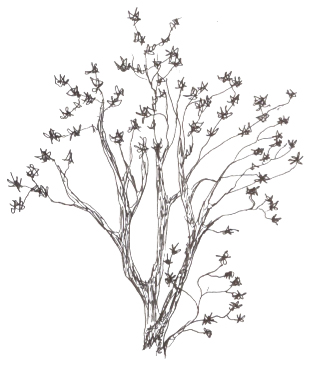Bulletin #2577, Native Trees and Shrubs for Maine Landscapes: Rosebay Rhododendron (Rhododendron maximum)
Developed by Marjorie Peronto, Associate Extension Professor, University of Maine Cooperative Extension; and Reeser C. Manley, Assistant Professor of Horticulture, University of Maine.
For information about UMaine Extension programs and resources, visit extension.umaine.edu.
Find more of our publications and books at extension.umaine.edu/publications/.
Go native!
This series of publications is the result of a five-year research project that evaluated the adaptability of a variety of native trees and shrubs to the stresses of urban and residential landscapes in Maine. Non-native invasive plants pose a serious threat to Maine’s biodiversity. Plants such as Japanese barberry, shrubby honeysuckle, and Asiatic bittersweet, originally introduced for their ornamental features, have escaped from our landscapes, colonizing natural areas and displacing native plants and animals. By landscaping with native plants, we can create vegetation corridors that link fragmented wild areas, providing food and shelter for the native wildlife that is an integral part of our ecosystem. Your landscape choices can have an impact on the environment that goes far beyond your property lines.
Description
Form: an irregular, open tree with picturesque upright branches
Size: 20 to 35 feet high, typically one-third to one-half the height
Ornamental characteristics:
- large, bell-shaped flowers, rose pink to lavender or white, with yellow spots on the inside of upper lobe
- dark blue-green, evergreen leaves
Landscape Use
Tolerant of shade and demanding moist soil and cool temperatures, rosebay rhododendron can be found growing on cool mountain slopes, along stream banks, and in moist woods, sheltered coves, and cold northern swamps. It belongs in the shadier and wetter areas of your landscape, growing with striped maple (Acer pensylvanicum), eastern arborvitae (Thuja occidentalis), Canada hemlock (Tsuga canadensis), mountain laurel (Kalmia latifolia), and witch hazel (Hamamelis virginiana). Rhododendron maximum is intolerant of most landscape stresses, including salt, drought, heat, and soil compaction.
This is an excellent broadleaf evergreen tree to line a long, shady driveway. It will form a continuous thicket of picturesque upright branches, covered with trusses of flowers in mid to late June.
For this plant to thrive in the landscape, the soil pH must be maintained at 4.5 to 5.5; otherwise, plants may develop chlorosis (yellowing) and grow poorly. Plants should be sited where they will not be exposed during the winter to direct sun or wind.
Culture
Hardiness: USDA zone 3b
Soil requirements: prefers moderately to well-drained, acid soils
Light requirements: shade-tolerant
Stress tolerances:
soil compaction — intolerant
pollution — intolerant
deicing salts — very intolerant
urban heat islands — intolerant
drought — intolerant
seasonal flooding — tolerant
Insect and disease problems: frequent—stem canker, bud and twig blights, crown rot, root rot, azalea stem borer, azalea leaf miner, and winter desiccation
Wildlife Value
In general, rosebay rhododendron is low in wildlife value, although the seeds are eaten occasionally by songbirds and small mammals.
Maintenance
Irrigation: During the establishment period, defined as one year after planting for each inch of trunk diameter at planting time, water your trees regularly during the growing season. Give the root zone of each tree 1 inch of water per week; in general, a tree’s root zone extends twice as wide as its canopy. After the establishment period, provide supplemental irrigation during periods of severe drought.
Fertilization: Landscape trees and shrubs should not be fertilized unless a soil test indicates a need. Correct soil pH, if necessary, by amending the backfill soil. No nitrogen fertilizer should be added at planting or during the first growing season.
To learn more about native woody plants
Visit the Eastern Maine Native Plant Arboretum at University of Maine Cooperative Extension’s Penobscot County office, 307 Maine Avenue in Bangor. Established in 2004, the arboretum displays 24 different native tree and shrub species that can be used in managed landscapes.
Reviewed by Cathy Neal, Extension professor, University of New Hampshire Cooperative Extension.
Photos by Reeser C. Manley.
Illustration by Margery Read, Extension Master Gardener.
This series of publications and the associated research were made possible in part by the Maine Forest Service’s Project Canopy.
Information in this publication is provided purely for educational purposes. No responsibility is assumed for any problems associated with the use of products or services mentioned. No endorsement of products or companies is intended, nor is criticism of unnamed products or companies implied.
© 2008
Call 800.287.0274 (in Maine), or 207.581.3188, for information on publications and program offerings from University of Maine Cooperative Extension, or visit extension.umaine.edu.
In complying with the letter and spirit of applicable laws and pursuing its own goals of diversity, the University of Maine System does not discriminate on the grounds of race, color, religion, sex, sexual orientation, transgender status, gender, gender identity or expression, ethnicity, national origin, citizenship status, familial status, ancestry, age, disability physical or mental, genetic information, or veterans or military status in employment, education, and all other programs and activities. The University provides reasonable accommodations to qualified individuals with disabilities upon request. The following person has been designated to handle inquiries regarding non-discrimination policies: Director of Equal Opportunity and Title IX Services, 5713 Chadbourne Hall, Room 412, University of Maine, Orono, ME 04469-5713, 207.581.1226, TTY 711 (Maine Relay System).




